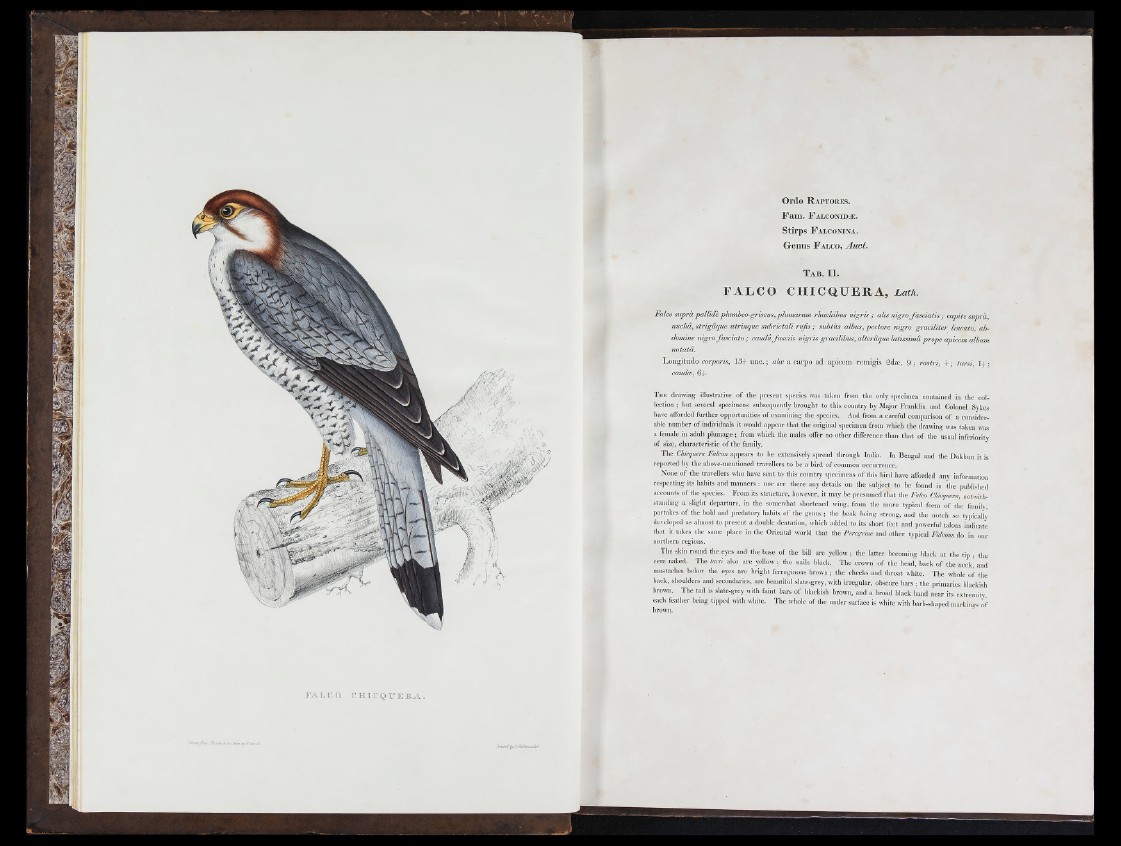
Ordo R a p t o r e s .
Fam. F a l c o n id a 2.
Stirps F a l c o n i l a .
Genus F a l c o , Au c t.
T a b . II.
FALCO CHICQUBRA,
Falco su p rà p a llid e p lumhco-griseus, p liim a rum rh a ch ib u s n ig r is ; a lis n ig ro fa s c ia t i s ; ca p ite suprà,
n u ch a , s tr ig d q u e tifr in q u e su b r ic ta li rtijis ; su b tils alb u s, p e c to r e n ig ro g r a c ilite r lin ea to , ub-
domine n ig ro fa s c ia to ; c a u d a fa s c iis n ig r is g ra c ilib u s , a lte rd q u e la tis s im a p r o p e apic em album
n o ta ta .
L o n g itu d o coryjom, 1 3 f u n c .; a/«.’ a c a rp o a d ap ic em rem ig is S dte , 9 ; ro s tr i, f ; ta rsi, l-> •
eauda;, fif.
T h e (Irawhig illustrative of the present species was taken from the only specimen contained in tiie collection
; blit several specimens subsequently brought to this country by Major Franklin and Colonel Sykes
bave alìbrded fa rthe r opportunities o f examining the species. And from a careful comparison o f a considerable
number of individuals it would ajipcar that the original S])ccimen from which the drawing was taken was
a female in adult plumage; from which the males ofler no otlier difference than th a t o f the usual inferiority
of size, characteristic o f the family.
The Chicqucra Falcon appears to be extensively spread througli India. In Bengal and the Dukliun it is
reported by the above-mentioned travellers to be a bird of common occurrence.
None o f the travellers who have sent to this country specimens o f tliis bird have afforded any information
respecting its liahits and manners : nor arc there any details on the subject to be found in tiie published
accounts o f the species. From its structure, however, it may bo presumed that the Falco Chicqucra, notwitli-
staiiding a slight dejiarture, in the somewhat shortened n-ing, from the more tyjiical form of the family,
partakes o f the bold and predatory habits o f the genus ; the beak being strong, and the notch so tvjiicaÌly
developed as almost to present a double dentation, wliich added to its short feet and powerful talons indicate
that it takes the same place in the Oriental world that the Peregrine and otlier typical Falcons do in our
northern regions.
The skin ronnil the eves imtl the base of tlie hill are yellow ; the latter becoming black a t the tip ; the
cere naked. The ta n i also ore yellow ; the nails black. The crown o f the head, back of tlie neck’ and
iiiiistaclics below the eyes arc bright ferruginous brow-ii ; the checks and throat white. The whole o f the
back, shoulders and secondaries, arc beautiful slate-grey, with irregular, obscure bars ; the primaries hlackisli
brown. Tlie tall Is slate-grey with faint bars of blackish brown, and a broad black band near its extremity
each feather being tipped with white. The whole o f the under surface is white with barli-sliapcd markings of
brown.
I ' h C D r . l i :i c o IT ili l i A o